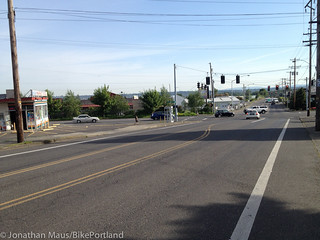
looks like? You won’t know unless you ask.
(Photo: J. Maus/BikePortland)
There’s a lot of talk about equity in the transportation planning world these days.
Here’s an example of how the City of Portland is handling geographic equity in the roll-out of a major initiative:
Vision Zero is one of the largest efforts the Portland Bureau of Transportation is currently involved in. In fact, along with bike share, Vision Zero is probably the highest priority project for PBOT Director Leah Treat. She is throwing a lot (relatively) of her agency’s capacity and resources toward the planning and policies it will take to make Vision Zero a real thing and not just another buzzword.
Will the Vision Zero campaign be successful in Portland? Will we really eliminate serious injuries and deaths by 2025? That remains to be seen. There’s a long way to go. But so far PBOT is at least talking to the right people. And by that I mean people who don’t have easy access to the central city or City Hall itself. And people who bear an undue amount of those injuries and deaths.
On Monday the city is bringing Vision Zero to the Cully neighborhood in outer northeast Portland. They’re hosting a Safe Streets Fair at the Living Cully Plaza on the corner of NE Killingsworth and Cully. The event welcomes everyone in the community with free food, a Spanish interpreter (and other languages if needed), childcare and prizes.
The goal? To hear what safe streets mean to people who live in Cully.
Advertisement
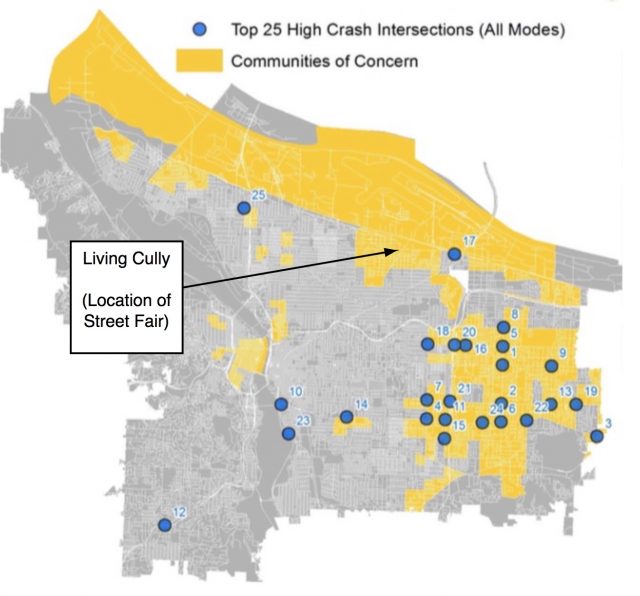
This is from the event invite:
– Engage in transportation safety activities
– Share your vision for safe streets in Portland
– Provide feedback on problem areas
– Learn about Portland’s Vision Zero plans
And here’s the impressive list of partner organizations (note that many of them aren’t the ones we usually see on transportation initiatives):
We’re nearly one year into Portland’s Vision Zero effort and this isn’t the first time PBOT has left the comfy confines of downtown. You might recall that the kickoff event was held at a community space on SE Division at 82nd that’s run by the Asian Pacific American Network of Oregon.
Equity has played a central role in PBOT’s Vision Zero efforts not because it’s a buzzword, but because the places in our city where people are most negatively impacted by traffic violence are also the places where people tend to have lower incomes, fewer English speakers, and less access to the institutional power that often leads directly to safer streets many Portlanders take for granted.
If you live, ride, or work in the Cully neighborhood, stop by the Living Cully Plaza (6723 NE Killingsworth) on Monday (June 6th) between 6:00 and 7:30 pm and tell PBOT what safe streets look like to you. More info at PortlandOregon.gov.
— Jonathan Maus, (503) 706-8804 – jonathan@bikeportland.org
Our work is supported by subscribers. Please become one today.


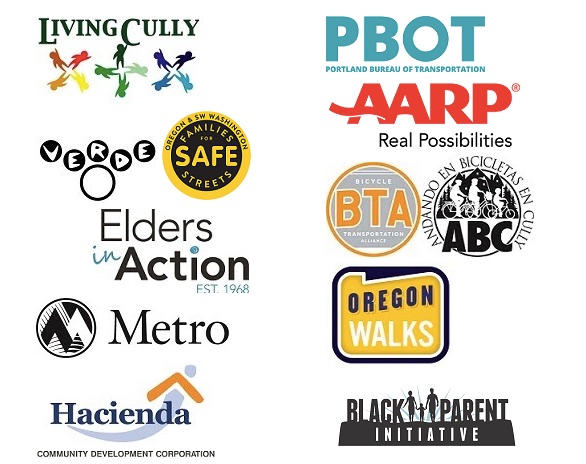
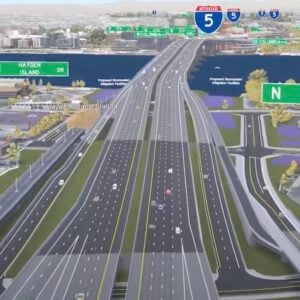
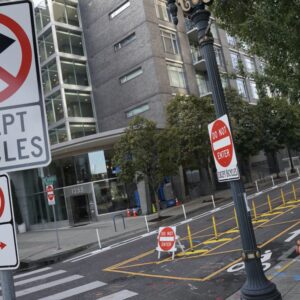
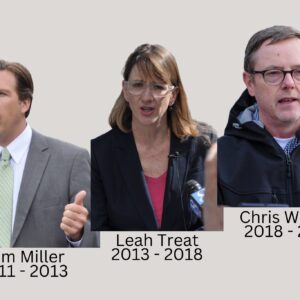
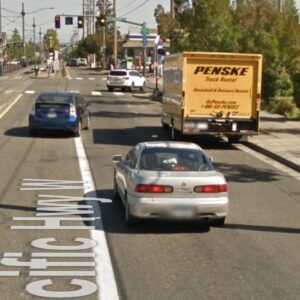
Thanks for reading.
BikePortland has served this community with independent community journalism since 2005. We rely on subscriptions from readers like you to survive. Your financial support is vital in keeping this valuable resource alive and well.
Please subscribe today to strengthen and expand our work.
It will be interesting to see if “safe streets” look the same to people in Cully as they might to bicycle oriented inner-core dwellers that tend to inhabit this site. We’ve seen in other contexts that different parts of the city tend to make different tradeoffs.
exactly… this part of the city (NE Killingsworth and Cully) is more like a suburb (1 block from a 45 mph street) and thus people will have more suburban thinking that is contrary to smart growth and multi-model travel…
What I’m really interested in is whether communities should get what they want, or what we think they need.
I used to think that democracy was a great idea until I realized that the majority of people are clueless about the best solutions for everybody…
we need leaders that are strong enough to do what’s right, not what’s popular…
Vote Trump! He’ll build a wall and make Cully pay for it!
and there will be lots of free parking.
Are you serious? I live in this area and there is nothing suburban about it. Lots of people walk, ride bikes and take transit out here mostly because it is one of the poorest neighborhoods in the city and many cannot afford a car.
yes, I’m serious in that it seems very suburban to me… besides the 45 mph road a block away, I see 2 strip malls, a used car lot, and a mini mart on the corners… that’s just screaming suburbs… it’s a wide open huge piece of pavement that’s not fun to bike on…
yes, there are bike lanes, and the speed of those 2 streets is only 30 and 35 mph, and there’s a grocery store .6 miles away… but that doesn’t change the fact that it’s a car-designed area that fits in with a suburb…
I’d much rather bike on any street downtown than bike at Killingsworth and Cully… I’ve bike on them both and they feel the same as taking the lane on Powell or 39th… it’s not fun because cars are in charge…
A few streets in a neighborhood do not define the entire neighborhood.
It looks suburban because it was designed that way 50 years ago. The original suburbanites are long gone. Just because it doesn’t look like Belmont Dairy doesn’t make it any less urban than anywhere else in Portland. It’s the people that make a neighborhood, not the building stock.
What is a “suburban person” though? This is more an issue of land use and density and Cully is low density and auto-oriented.
Additionally, I would argue that most of inner southeast is suburban as well.
How do you define urban, exactly?
Larger-scale mixed-use buildings with streets that promote a variety of transportation modes. Downtown, the Pearl, Goose Hollow, NW District all fit this model, as do many east coast cities, cities built up before 1900, and most European cities. Even row-houses qualify as urban if they front the street with no front yard. Neighborhoods that are exclusively single-family detached houses with large setbacks are not urban development. Most of southeast is a first-ring streetcar suburb.
It’s those damn front yards that are the problem. People use them to grow flowers and other hippie shit.
You don’t need all concrete and apartment buildings to be a “real” city.
Adam, I agree that most of SE & NE Portland are “suburban”, but not quite for the same reasons as you state.
For me “urban” is defined by a density of people (but not of households.) 4 of the 5 densest neighborhood associations in Portland are in the downtown core area (Downtown, Old Town, Pearl, & NW), but the fifth is Glenfair, far to the east, a mixed development with crowded (and ugly) woody-walkup apartments and a high-poverty high-crime population, the Rosewood/Rockwood area, from Glisan to Stark, and from 148th to 162nd, an area you would probably define as “suburban.”
The city I live in, Greensboro NC, has 288,000 folks living in an area roughly the size of Portland; half the number of people, therefor half the density. The vast majority of this “east coast” city is “suburban” by both of our definitions. It is only near the two universities here (UNCG & NCA&T) that you get “urban” densities and housing (10-story student dorms.) Like Portland, some of the densest neighborhoods are run-down 2-story woody-walkup apartments, “affordable by accident” slums, complete with ethnic minorities, “poor white trash”, rats, and roaches everywhere.
However, unlike Portland, people here are invariably friendly towards one another, black, white, Asian, or green alien. Southern charm really exists.
By “bicycle oriented inner-core dwellers” do you mean “white people”?
I think if you asked anyone in Cully, they would tell you that safe streets = opportunities for active transportation.
If I meant white people I would have written that.
What I mean is that in other parts of the city, many people have shown that they don’t always prioritize active transportation. I’m interested in both (vastly) improving cycling infrastructure, and devolving power to give local residents maximum control over their streets and neighborhoods. I’m particularly interested when these two agendas clash. I don’t frankly know what the residents of Cully want. But if they would rather have improved auto infrastructure at the cost of active transportation, should they get it? That, to me, is a very interesting question.
We had an extensive transportation survey about two years ago in East Portland, east of 82nd & 205, which pointedly does not include Cully. The survey went out to all 58,000 East Portland households, with a 3% response rate (which is considered pretty good by today’s low standards.) PBOT was one of about 8 organizations who worked on the questions, so they had nearly no control over the survey.
Most respondents (72%) did not even own a bike, let alone support bicycling infrastructure, but most did want to see more sidewalks and pedestrian island crossings, which PBOT is now implementing. Many (certainly over 10%) wanted more freeways, wider roads, and more parking throughout Portland (none of which PBOT would ever be willing to do.) Most wanted more transit service, especially north-south, to connect to existing employment patterns (only about 7% of East Portland workers work downtown; far more work along the Columbia Corridor.)
My guess is that if East Portland had full control of its transportation funding, it would expand transit service to Clackamas and Clark Counties, massively cut bus service to downtown (but not light rail), build more sidewalks and ped islands, and turn 122nd into a freeway. And biking would still suck.
Cully is not what I think of as suburban – in lots of ways. I suppose if one considers “suburban” as synonymous with “car-centered” then sure, but that applies to an awful lot of the city of Portland – and most other cities, for that matter.
Also, I worked in this neighborhood for about 6 years, and it’s no dream ride, but it’s a distant cry from riding on Powell!
Still, I think the gist of your point – that attitudes are likely to be different than in the central east side – is more or less right.
Most of the the east side of Portland inside 82nd is a first-generation streetcar suburb. Cully, being outside of the reach of the streetcar is a second-generation suburb that grew out of car usage, rather than streetcar as the primary mode of transport. Cully wasn’t even part of the City of Portland until the 1980’s. Just because the neighborhoods now have been absorbed into the City of Portland does not mean they weren’t built as suburbs in the first place. Urban vs. suburban is more of a function of land use and transportation mode than it is about what governmental body the area is incorporated under.
I suppose in my mind it doesn’t seem like a typically suburban area, based on the fact that it is a pretty clear, uninterrupted continuation of Portland’s street grid, has sidewalks for the most part, has good access to bus lines, etc.
And, as Hazel pointed out, it is very common to see people getting around by foot and bike – again, not what I associate with being quintessentially suburban.
Actually I’d wager that far more than half the streets in cully do not have sidewalks which is part of the problem, especially high traffic streets like 72nd between prescott and killingsworth or cully on the west side going north from fremont.
slide 9 and 11:
http://www.portlandoregon.gov/bps/article/454494
Thanks for posting about this, I am pretty surprised that although this outreach is only 2 days away and I live in Cully this is the first I have heard of it. You’d think the City would have done more to communicate about it, either flyers up around the neighborhood or mailers or something.
Do you attend your neighborhood association’s meetings? Seems like it would at least be in the newsletter.
I go sometimes but not every month. The newsletter would have been a good place for the city to communicate about this. I just double checked and there is nothing about it in the newsletter it isn’t even listed on the calendar.
I help organize an annual pedalpalooza event in Cully. It is pretty possible to safely route around cully south of Killingsworth, but there are several businesses that I would like to have our ride go to but we simply can’t because in many areas North of Killingsworth I simply feel there is no safe way to lead a ride.
Darn, this is my neighborhood and I’ll be out of town. (this is the first I heard of this event also) Crossing Cully at Skidmore on my daily ride can range from slightly stressful, all the way up to taking-life-in-hands. It’s mainly the speed of cars along the stretch of Cully from Fremont to Prescott, presence of heavy commercial vehicals and the lack of visibility coming around the curve.
If I could be there, I’d tell PBOT that traffic-calming measures, lower-speeds, better visibility for bike lanes, and safer street-crossings would mean safer streets to me. For anyone going, feel free to pass this along!
Can you tell us where we can find a bigger version of that high crash map?
I’m not sure of the map, but the data seems to be from 2013. In 2014, 174th & Powell went from being the 3rd worst (as on the map) to 2nd.
Data from PBOT: http://www.portlandoregon.gov/transportation/article/549274
N,
this map is interactive:
http://www.portlandoregon.gov/transportation/article/522791
I find it strange to hear Cully referred to as a neighborhood in “outer northeast Portland”. When I think of outer NE Portland, I more typically think of NE 162nd. Hell, Portland’s extreme NE edge extends out to 185th and Marine Drive.
I feel that anyone that is able to live in Cully, let alone anywhere West of 205, is privileged to live so close in, and I am envious of their easy access to infrastructure.
It may have been “outer” a generation or two ago, but doesn’t even seem “mid” now.